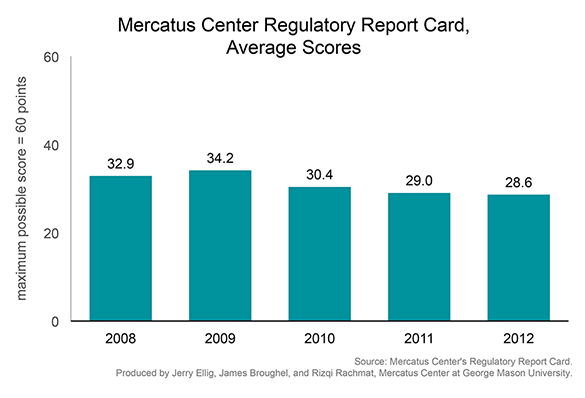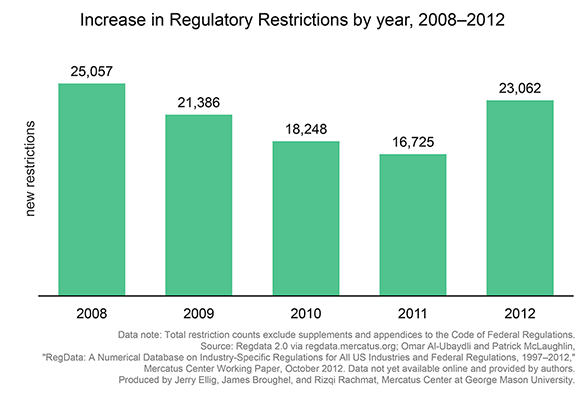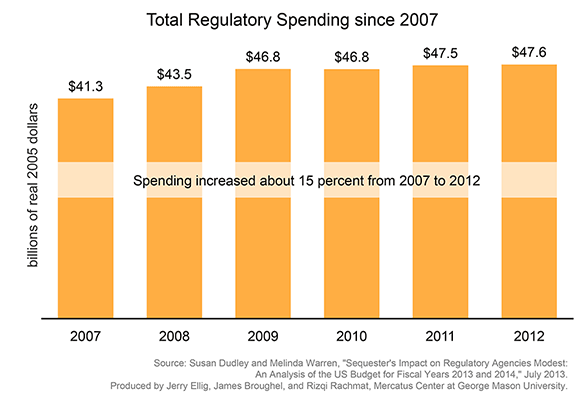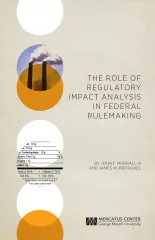- | Regulation Regulation
- | Data Visualizations Data Visualizations
- |
While Regulatory Spending and Output Increase, Economic Analysis of Regulations Is Often Incomplete
Federal regulatory agencies consume enormous amounts of time and resources in producing approximately 3,000 final regulations each year. Agencies have seen sizable increases in their budgets in the last several years, as they have added thousands of new rules and requirements to the books. Unfortunately, the evidence suggests that these increases have not necessarily meant resources have been used well.
Federal regulatory agencies consume enormous amounts of time and resources in producing approximately 3,000 final regulations each year. Agencies have seen sizable increases in their budgets in the last several years, as they have added thousands of new rules and requirements to the books. Unfortunately, the evidence suggests that these increases have not necessarily meant resources have been used well.
As the chart below demonstrates, 104,478 new regulatory restrictions were added to the Code of Federal Regulations (CFR) between 2008 and 2012. At the same time, more than 18,000 regulations were finalized. Regulatory restrictions are words that signify a binding constraint that restricts behavior. These are words like “must,” “shall,” or “may not” that appear in regulatory text. In 2012 alone, agencies added over 23,000 restrictions to the CFR.
Budget growth paralleled the rise of regulatory requirements. For example, total spending by regulatory agencies increased by $6.4 billion (2005$) during fiscal years 2008 through 2012. Budget growth averaged just under 3 percent per year, which meant that budgets increased roughly 15.5 percent between 2007 and 2012.
Given the more active role regulatory agencies are playing in the lives of Americans and the added responsibilities taxpayers have given agencies by way of increased budgets, it is important to ask what kind of progress agencies are making towards improving the well-being of Americans. Is the quality of agency results improving as responsibilities and resources increase?
Unfortunately, we do not know the answer to that question because the economic analysis agencies conduct when they issue regulations is often seriously incomplete. The Mercatus Center’s Regulatory Report Card assesses the quality and use of economic analysis for economically significant regulations. Researchers evaluate the analysis accompanying each regulation and assign a score ranging from zero to 60 points. The average score for all prescriptive regulations between 2008 and 2012 was about 31 points or just over 50 percent. This is a failing grade by the standards of most teachers. If we add in budget regulations (rules that implement federal spending and revenue collection programs like Social Security and Medicare) the scores drop further.
Even worse, agencies often fail to score well on very basic criteria in the Report Card, such as identifying the problem they are trying to solve, or demonstrating how a regulation is likely to achieve its desired outcome. If agencies can’t even provide basic answers to these questions, what faith can the American public have that increases in resources provided to agencies will be put to good use? And what faith can the public have that the tens of thousands of new restrictions added to the books each year are solving real problems and producing real benefits?
 The failure to improve the quality of analysis despite expanding budgets is explained by the incentives agencies face. Agencies are rewarded for adding new rules to the books—not necessarily for ensuring that the rules solve real problems at a reasonable cost.
The failure to improve the quality of analysis despite expanding budgets is explained by the incentives agencies face. Agencies are rewarded for adding new rules to the books—not necessarily for ensuring that the rules solve real problems at a reasonable cost.
If agencies are going to be asked to write thousands of new rules year after year and be rewarded with ever larger budgets at the same time, there should be a way to hold regulators accountable for the quality of the analysis that is supposed to inform regulatory decisions. Otherwise, rules are unlikely to achieve intended results. One way to improve the quality of analysis would be for Congress to mandate that agencies produce economic analysis that satisfies basic standards of quality, as defined by current executive orders and OMB guidelines. Unless agencies are pressured by the other branches of government to improve, the status quo will likely continue to prevail, and American taxpayers will continue to wonder what all the new spending and regulations are actually achieving.




